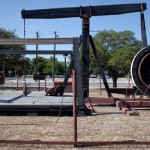With Noise Pollution Growing at Sea, A Texas Team Looks for Answers

Photo by LUIS ROBAYO/AFP/Getty Images
The research team may have found a way to mitigate the effects of oil drilling and shipping noise on sea life.
One of the insidious things about noise pollution is that it is invisible. While the long plume that rose after the Deepwater Horizon explosion is a discernible reminder of how oil can harm the ocean, the sound that explosion made is less tangible.
But recent research shows that the noise caused by human activity, like noise from oil shipping and drilling, is having a negative impact on the marine ecosystem. That’s lead to new research and the possibility of new regulation, all aimed at keeping human activity quieter.
Growing Evidence that Noise is a Problem Underwater
In one recent study, a group of researchers from the New England Aquarium gauged the stress levels of whales by measuring hormones in whale droppings. They discovered there was a brief window of time right after the September 11th terrorist attacks when whales appeared more relaxed than usual.
Scientists think it might have something to do with the fact that shipping traffic was restricted in the weeks following 9/11.
In another study, researchers from Norway tracked fish catches in an area where seismic airguns were being used to explore for oil. The result: certain fish catches declined after the guns were used, while the presence of other species increased.
“If the data are correct and can be replicated, the issue comes down to: ‘Well, is this affecting fisheries around the world?'” Dr. Arthur Popper, a scientist with the Aquatic Bioacoustics Laboratory at the University of Maryland, posed to StateImpact Texas.
“And as we do more things like developing wind farms, and oil exploration and geologic surveys and such, is this becoming a bigger and bigger issue?”
Popper points out that the ocean is pretty noisy without man’s influence. It’s full of sounds of animals communicating, from the spotted sea trout to the snapping shrimp.
When man-made noise begins to interfere with the natural back-and-forth of sea-dwelling creatures, it stands to reason that their behavior may be disturbed.
“It’s like walking in the country and it’s nice and quiet,” said Popper. “You can hear everything around you. And then you add lots of noise from construction or something, and it’s harder to hear the people around you, or sounds that you might be interested in hearing.”
That’s exacerbated by the fact that sound travels a lot farther underwater.
“There are places where sound can travel like five or ten thousand miles in the ocean. [But] it would never travel that distance in the air,” said Popper.

Photo by Mose Buchele foe StateImpact Texas.
Post Doctoral researcher Kevin Lee is working on bubble technology at UT's Applied Research Lab.
From Innovation to Regulation?
With concern growing over the impacts of man-made noise, a group of University of Texas researchers is looking into what can be done.
One morning early this month at UT Austin’s Applied Research Laboratories, Dr. Preston Wilson conducted a simple experiment. It’s the kind, as they say, you can try at home. He filled a beaker up with some water, and as he tapped on the beaker he added more water into it from a syringe. As the extra water goes in, the sharp sound of the tapping is dulled and quieted.
Wilson explains that it’s all about the bubbles that form when the extra water is added.
“The pinging sound is reduced, and as the bubbles rise up it eventually comes back to pinging,” he said.
The Navy has been using bubbles to mask ship sounds for years. Bubbles are also used to mask sound in some pile-driving operations. What Wilson and his team want to do is enhance that system and extend it to other operations at sea and in rivers and lakes.
They want to do it by encapsulating the bubbles, essentially putting them in balloons so that they can control their size and ensure the bubbles stay fixed in stormy weather. Dr. Wilson says these “balloon bubbles” could be strung on the ocean floor around a noisy construction operation or even wrapped around a noisy ship’s hull.
“You might imagine completely surrounding a source. Using not just a curtain, but a blanket maybe, or a jacket,” said Wilson.

Photo by Mose Buchele for KUT News.
Kevin Lee, Mark Wochner, and Preston Wilson work on bubbles at UT's applied research lab.
At the moment Wilson’s research is funded by Shell Oil. The team says they’ve already had talks with regulators who are interested in the technology, and with offshore construction contractors who believe the technology may be less expensive than existing noise mitigation.
“Government agencies want to have these [noisy] activities go forward to a certain extent,” said Wilson. “They don’t want to regulate them out of existence. So when a new technology allows for greater abatement, it may follow that the regulations become stricter.”
Marine Biologist Arthur Popper thinks that will be most useful right off the coast of Texas in the Gulf of Mexico, home of tanker ships, oil rigs and no lack of life under the sea.
“The way to think about this is that as human beings in the United States we have a lot of regulations for noise in the environment, because its known that noise can cause all sort of problems,” said Popper. “And we’ve been realizing that as human pour sounds into the ocean, that this has the same effect on marine life.”


